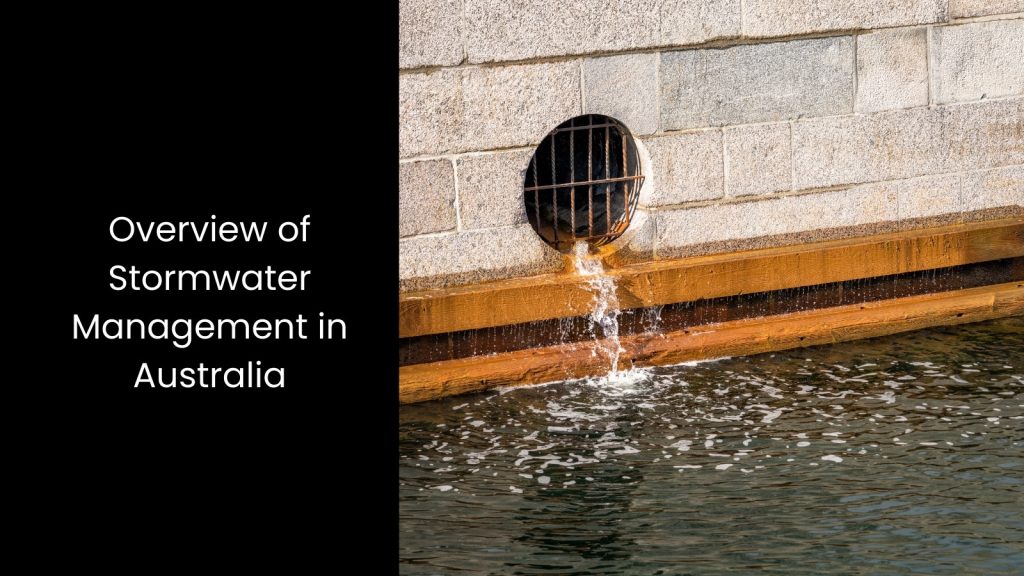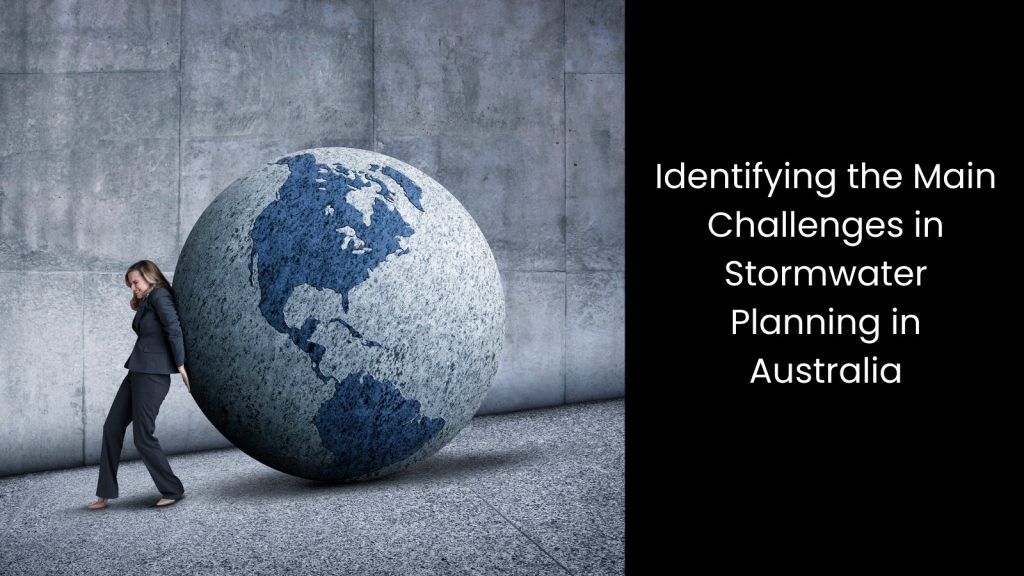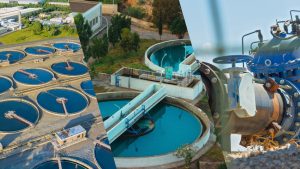Stormwater management authorities in Australia have to constantly be aware of how to protect cities from increasing floods, pollution, and infrastructure strain in the face of urbanisation and climate change. With extreme weather events becoming more frequent and intense, the country’s ageing stormwater systems struggle to keep pace with growing demands. Urban development replaces natural landscapes with concrete, generating more runoff and overwhelming drainage networks. As a result, the stakes are high. Authorities must navigate complex challenges while balancing costs and long-term sustainability.
In this article, we will understand the rising challenges in stormwater planning in the Australian landscape.
In this article, we will understand the rising challenges in stormwater planning in the Australian landscape.
Overview of Stormwater Management in Australia

First, let us give you a glimpse of overall stormwater management in Australia. However, before that, we should understand what this stormwater planning concept is.
- Stormwater planning means developing strategies and actions designed to manage the flow of rainwater runoff in urban areas, particularly as it moves through cities, towns, and infrastructure systems. It plays an essential role in a country’s urban planning and environmental conservation, as it helps control flooding, protect water resources, and reduce pollution.
- In Australia, stormwater management is crucial due to the country’s varying climate and diverse geography. With increasing urbanisation and the growing impact of climate change, effective stormwater management becomes vital for maintaining water quality, protecting aquatic ecosystems, and ensuring long-term water security.
- The problem starts with Australia traditionally relying on engineered systems like pipe networks and concrete channels to divert stormwater away from urban areas to prevent flooding. Yes, it is true that this method succeeded in flood control. However, it also introduced several environmental and social issues, including degraded water quality, loss of natural habitats, and the exacerbation of urban heat islands.
- As a result, Australian cities have started shifting towards more sustainable stormwater management practices, especially Water Sensitive Urban Design (WSUD). However, the back-to-back challenges that come with stormwater planning have not completely vanished yet.
Identifying the Main Challenges in Stormwater Planning in Australia

Urbanisation
Urbanisation presents significant challenges to stormwater planning in Australia. Do you know why?
It is primarily due to the rise of impervious surfaces like roads, rooftops, parking lots, etc. As cities expand, natural landscapes that once absorbed rainwater give way to hard surfaces that prevent water from soaking into the ground. This shift causes a dramatic increase in stormwater runoff, which strains the capacity of existing drainage systems.
When heavy rainfall occurs, the excessive runoff can quickly overwhelm stormwater infrastructure. This will lead to localised flooding and erosion beyond doubt.
On one hand, the increased volume of water also carries various pollutants, including oils, chemicals, sediments, and debris, which can enter rivers, lakes, and oceans, degrading the quality of these water bodies. On the other hand, urban areas usually rely on older drainage systems that were not designed to handle the volume of runoff that modern cities now produce. Consequently, these systems struggle to manage the demands of growing populations and expanded infrastructure, putting pressure on local councils and environmental agencies to find innovative solutions.
It does not end there. Urbanisation also disrupts the natural water cycle, which affects groundwater replenishment and increases the risk of heat island effects, where cities become significantly warmer than their surrounding areas.
It is primarily due to the rise of impervious surfaces like roads, rooftops, parking lots, etc. As cities expand, natural landscapes that once absorbed rainwater give way to hard surfaces that prevent water from soaking into the ground. This shift causes a dramatic increase in stormwater runoff, which strains the capacity of existing drainage systems.
When heavy rainfall occurs, the excessive runoff can quickly overwhelm stormwater infrastructure. This will lead to localised flooding and erosion beyond doubt.
On one hand, the increased volume of water also carries various pollutants, including oils, chemicals, sediments, and debris, which can enter rivers, lakes, and oceans, degrading the quality of these water bodies. On the other hand, urban areas usually rely on older drainage systems that were not designed to handle the volume of runoff that modern cities now produce. Consequently, these systems struggle to manage the demands of growing populations and expanded infrastructure, putting pressure on local councils and environmental agencies to find innovative solutions.
It does not end there. Urbanisation also disrupts the natural water cycle, which affects groundwater replenishment and increases the risk of heat island effects, where cities become significantly warmer than their surrounding areas.
Concerns Regarding Water Security
This country has a unique climate and an increasing demand for water resources.
If we further elaborate, Australia experiences frequent droughts and variable rainfall patterns, which makes managing and securing water supply difficult, especially in urban areas. As cities grow and more people rely on limited water resources, the need for sustainable water management becomes a top necessity.
Stormwater is certainly a valuable resource, yet it gets wasted as it rapidly flows off impervious surfaces like roads and buildings instead of being captured and reused. The traditional stormwater systems focus on quickly diverting runoff away from urban areas to prevent flooding, but this approach neglects the potential to use stormwater for water supply.
Without efficient stormwater planning, a large portion of rainwater ends up polluting rivers, lakes, and oceans rather than being treated and reused for purposes like irrigation, groundwater replenishment, or even drinking water in some cases. Even implementing WSUD in rapidly growing cities can be challenging due to the need for expensive infrastructure upgrades and the complexities of retrofitting existing systems.
If we further elaborate, Australia experiences frequent droughts and variable rainfall patterns, which makes managing and securing water supply difficult, especially in urban areas. As cities grow and more people rely on limited water resources, the need for sustainable water management becomes a top necessity.
Stormwater is certainly a valuable resource, yet it gets wasted as it rapidly flows off impervious surfaces like roads and buildings instead of being captured and reused. The traditional stormwater systems focus on quickly diverting runoff away from urban areas to prevent flooding, but this approach neglects the potential to use stormwater for water supply.
Without efficient stormwater planning, a large portion of rainwater ends up polluting rivers, lakes, and oceans rather than being treated and reused for purposes like irrigation, groundwater replenishment, or even drinking water in some cases. Even implementing WSUD in rapidly growing cities can be challenging due to the need for expensive infrastructure upgrades and the complexities of retrofitting existing systems.
Climate Change
This has been a headache for the Australian authorities as climate change significantly complicates stormwater planning in Australia. It does this by intensifying weather patterns and increasing the frequency of extreme storm events.
Heavier rainfall causes a spike in stormwater runoff, which can overwhelm existing drainage systems. You know that many of them were not built to manage such large volumes of water. As a result, urban areas face a higher risk of flash floods, property damage, and the degradation of infrastructure. Further, climate change also contributes to rising sea levels, which worsen coastal flooding and accelerate erosion along Australia’s extensive coastlines. No need to say that this adds an extra layer of complexity to stormwater management, especially in low-lying coastal cities, where infrastructure must cope with both increased runoff from storms and the encroaching threat of the ocean.
The unpredictability of rainfall patterns makes it harder for stormwater planners to develop reliable strategies that can handle the dual challenges of droughts and sudden heavy storms. In some regions, long dry spells can damage soil and reduce the capacity of natural landscapes to absorb water. What does this mean? It reflects that when the rain does come, it leads to more intense runoff. This further stresses an already overburdened stormwater network.
Heavier rainfall causes a spike in stormwater runoff, which can overwhelm existing drainage systems. You know that many of them were not built to manage such large volumes of water. As a result, urban areas face a higher risk of flash floods, property damage, and the degradation of infrastructure. Further, climate change also contributes to rising sea levels, which worsen coastal flooding and accelerate erosion along Australia’s extensive coastlines. No need to say that this adds an extra layer of complexity to stormwater management, especially in low-lying coastal cities, where infrastructure must cope with both increased runoff from storms and the encroaching threat of the ocean.
The unpredictability of rainfall patterns makes it harder for stormwater planners to develop reliable strategies that can handle the dual challenges of droughts and sudden heavy storms. In some regions, long dry spells can damage soil and reduce the capacity of natural landscapes to absorb water. What does this mean? It reflects that when the rain does come, it leads to more intense runoff. This further stresses an already overburdened stormwater network.
Ageing Infrastructure
It is a proven fact that stormwater infrastructure normally has an average lifespan of around 50 to 100 years. However, the problem is that much of Australia’s stormwater system is approaching or exceeding this limit.
The latter is indeed a challenge for stormwater planning because older systems were not designed to handle the increased volumes of runoff caused by modern urbanisation or the more intense weather events brought about by climate change, as we mentioned above. These outdated systems tend to suffer from wear and tear, blockages, and even structural failure, which reduces their ability to efficiently manage stormwater.
When storms occur, these ageing networks struggle to cope. It will lead to frequent flooding, damage to roads and properties, and contamination of water sources due to overflowing drains.
As cities expand, the demand for these old systems continues to grow, but retrofitting or replacing them can be a costly and complex process. Then comes an issue with limited budgets and the difficulty of upgrading systems in densely populated urban areas. It makes this task even more challenging for local councils and governments.
The challenge of dealing with this ageing infrastructure becomes even more urgent as Australia faces the impacts of climate change and increased urbanisation. If it gets further delayed to address these issues, then it will lead to higher maintenance costs, greater risks of system failure, and larger environmental consequences.
The latter is indeed a challenge for stormwater planning because older systems were not designed to handle the increased volumes of runoff caused by modern urbanisation or the more intense weather events brought about by climate change, as we mentioned above. These outdated systems tend to suffer from wear and tear, blockages, and even structural failure, which reduces their ability to efficiently manage stormwater.
When storms occur, these ageing networks struggle to cope. It will lead to frequent flooding, damage to roads and properties, and contamination of water sources due to overflowing drains.
As cities expand, the demand for these old systems continues to grow, but retrofitting or replacing them can be a costly and complex process. Then comes an issue with limited budgets and the difficulty of upgrading systems in densely populated urban areas. It makes this task even more challenging for local councils and governments.
The challenge of dealing with this ageing infrastructure becomes even more urgent as Australia faces the impacts of climate change and increased urbanisation. If it gets further delayed to address these issues, then it will lead to higher maintenance costs, greater risks of system failure, and larger environmental consequences.
Making Stormwater Planning Successful with Advanced Technology

It is evident that stormwater challenges continue to evolve, and so does the technology designed to solve them. If you could integrate advanced systems into stormwater planning, you would be able to gain the power to better predict, manage, and mitigate the risks ahead. You will gain the expected outcome if you collaborate with the right software provider.







